【Properties】Spicy, Hot
【Meridians】Heart, Spleen, Stomach, Kidney, Lung
(Changing style)
Opening the chapter on “warming herbs”, the first to be encountered is the old friend of the past (the 2016 article on ginger)— Ginger. Previously understood as a herb for releasing the exterior, it is likely that this understanding will be reinterpreted six years later, and old articles will have new chapters. (Quick link: Friend of Women, Warm Uncle—Ginger is so dirty)
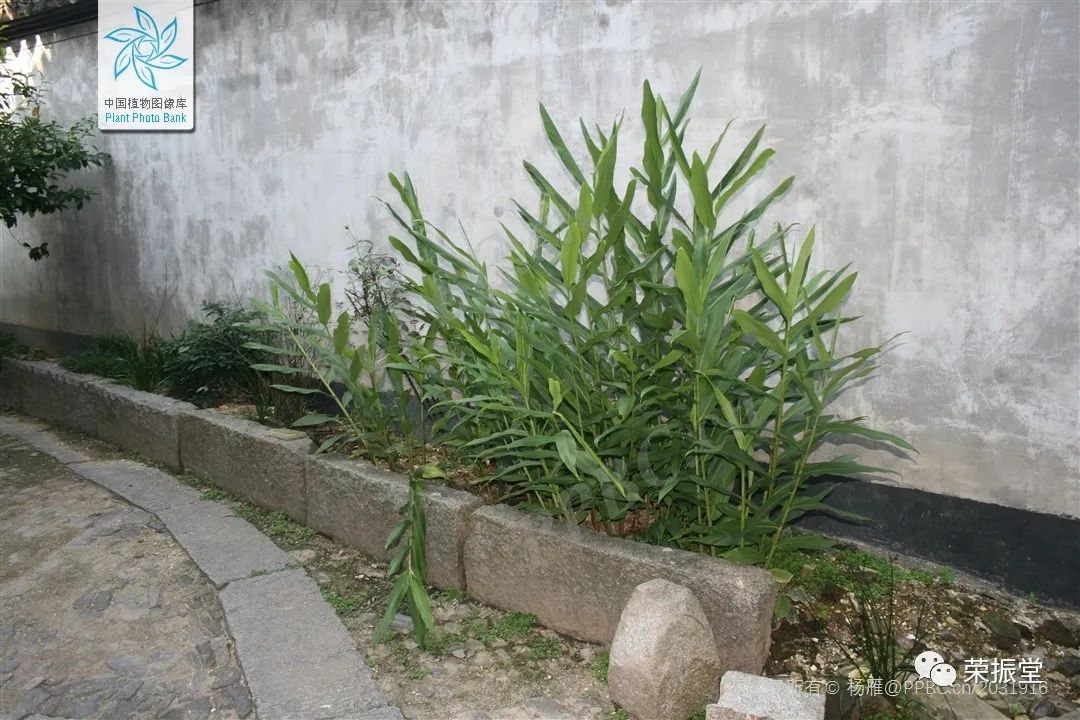
(Image from PPBC, taken by Yang Yan)Additionally, the difference between dried ginger and fresh ginger lies in the different harvesting times, picking parts, and processing methods of the same plant, resulting in different effects, which is worth learning again. The above image shows ginger plants by the wall in Yixian, Anhui.In traditional Chinese medicine literature, dried ginger has the effects of warming the middle and dispersing cold, reviving yang and unblocking meridians, and drying dampness and resolving phlegm, and is mainly used for treating symptoms such as cold pain in the abdomen, vomiting and diarrhea, cold limbs with weak pulse, and phlegm-damp cough.If you still don’t understand how the little bear analyzes Chinese medicine, please see the previous articles:Imagination One: Why Can Plants Be MedicineTheory Two: Plant Adaptation to the EnvironmentInteresting Three: The Impact of Harvest Time and Parts on Medicinal PropertiesConclusion Four: The Processing of Chinese Medicine is Like Adding Flowers to a Brocade
Understanding the Habitat of Ginger
KNOWING LIFE
Both fresh ginger and dried ginger come from the plant “Ginger” (Zingiber officinale Roscoe), which is a perennial herb of the Zingiberaceae family, reaching heights of over 1 meter. It has vigorous growth, and although many people start harvesting fresh ginger after more than six months of planting, there will always be residual roots in the soil.

(Image from PPBC, taken by Jin Honggang)The original habitat of ginger is in the tropical regions of Southeast Asia, preferring warm and humid climates. It has relatively weak cold resistance and drought resistance, and the plant can only grow during frost-free periods, with the optimal temperature for germination and growth being 25-28°C. It is said that when the temperature is below 20°C, ginger germinates slowly, and if frost occurs, the above-ground part of the plant will wither; if exposed to frost for a long time, the rhizome will completely lose its ability to germinate.This indicates that its tubers, when used as medicine, are positioned in the warm and moist areas of the earth.It is widely cultivated in central, southeastern, and southwestern China, while it is difficult to survive in the colder northern regions (of course, due to developed logistics, fresh ginger can be found everywhere).It is also commonly cultivated in tropical regions of Asia.
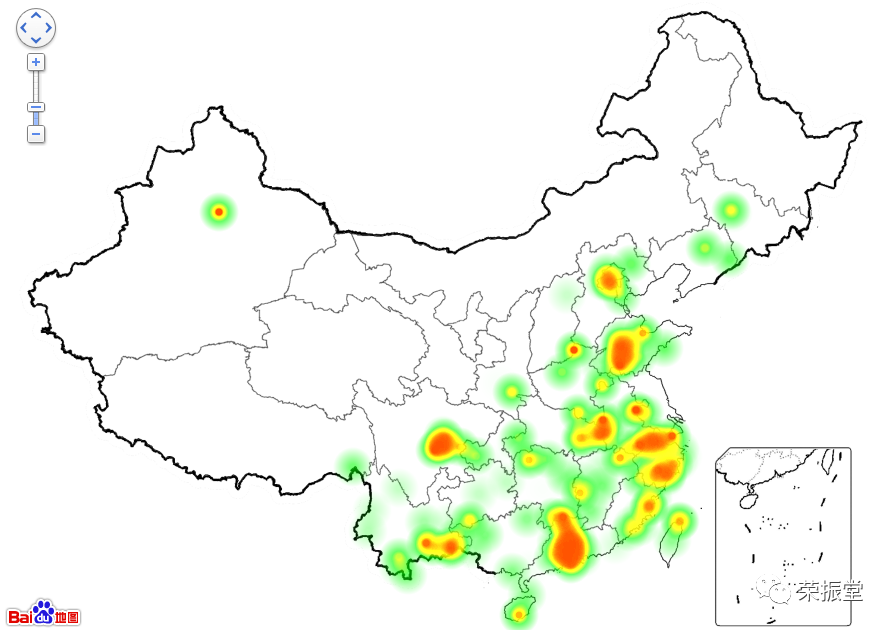
(Image from Plant Intelligence, Baidu provides map visualization, PPBC specimen heat map)
The reason it is not cold-resistant is that most of the plant’s roots are in shallow soil (roots deeper than 30 cm basically escape the cold of the ground), primarily producing lateral tubers, with a secondary growth of “adventitious roots + fibrous roots”. This structure determines that its (tubers, not yet distinguished as fresh or dried ginger) when used as medicine acts in the warm earth, with the tuber shape resembling the earth element, and the thin skin and thick flesh being yellow, representing the earth’s characteristics. Its upward-growing stem is thick and reddish at the base, thus symbolizing the blood aspect emerging from the earth and developing wood properties, drawing water from the depths.
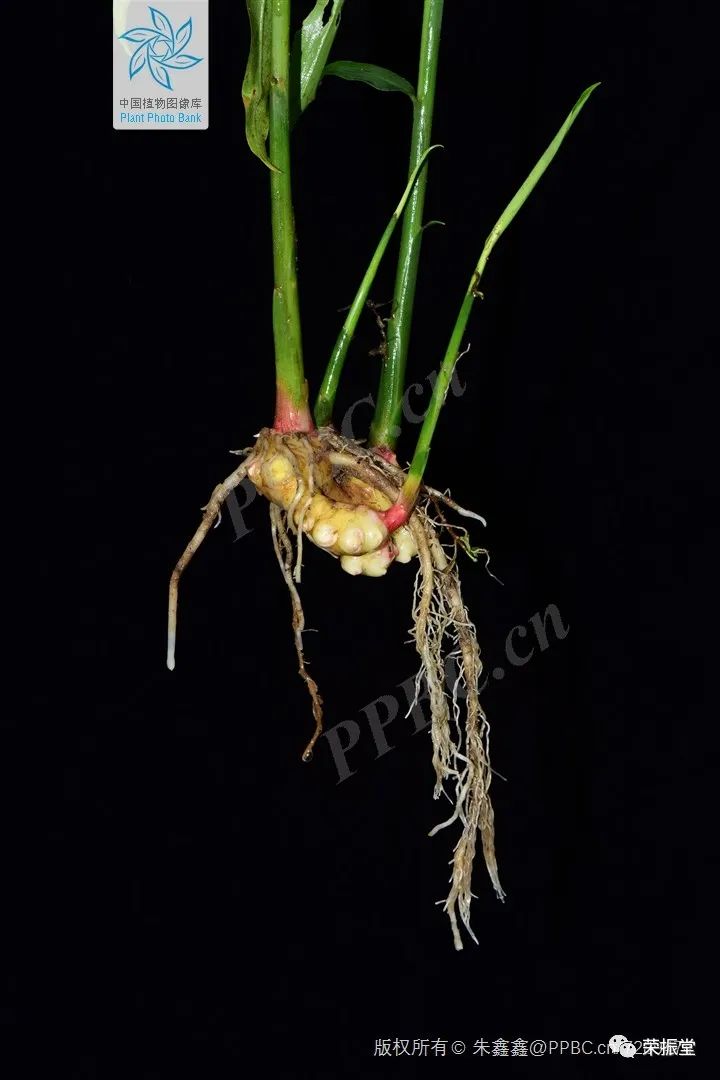
(Image from PPBC, taken by Zhu Xinxin)
Ginger is mostly propagated by dividing the rhizomes, preferring organic fertilizers and potassium, but after multiple harvests, the soil can become acidic (hence the need to avoid heavy cropping). The aforementioned earth and water aspects, combined with its hydrogen-potassium exchange, allow ginger to enter the stomach.(Although it seems a bit far-fetched, it is quite interesting; what if there is a connection?)
Once ginger is planted from tubers, it will begin to divide (of course, many people have ginger in their kitchens that will also sprout if not used in time). The newly formed small round tubers, which produce both stems and roots, are called “first-generation ginger tubers”, also known as “young ginger”. It can be seen that young ginger is red and round, resembling Aconite, but Aconite is purely for energy storage, while young ginger also serves the function of communication.
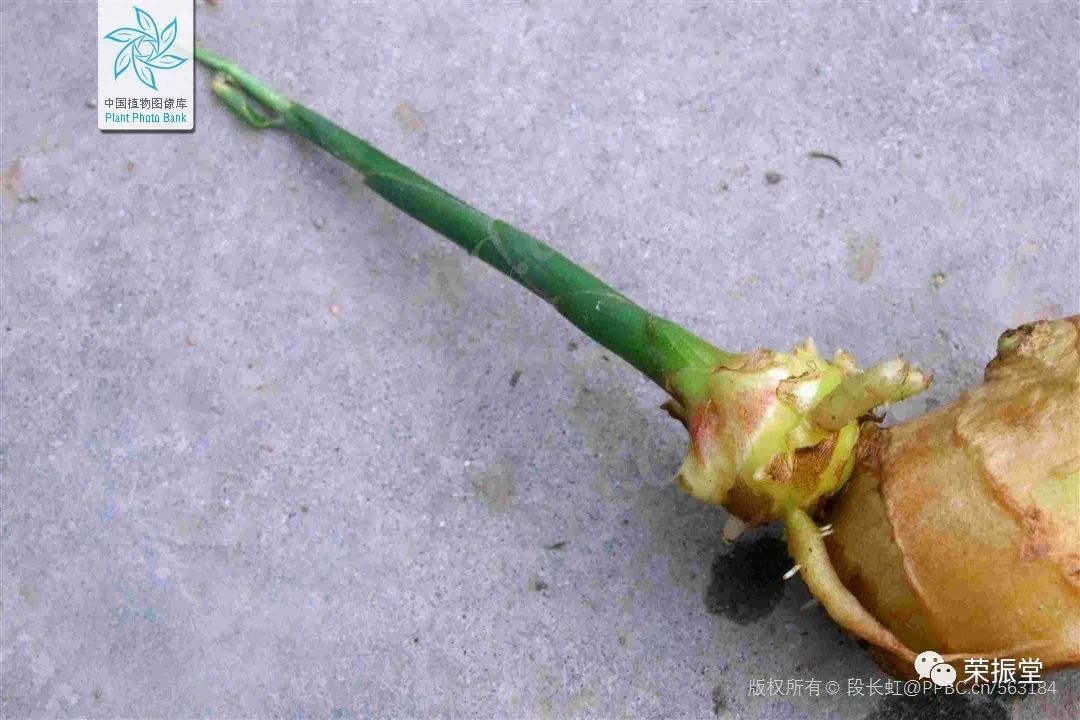
(Image from PPBC, taken by Duan Changhong)
The above-ground part of ginger, starting from the stem, is already emitting the unique aroma of ginger (aromatic and spicy). The stem is not woody (not shaking) but is covered by leaf membranes (already yielding).
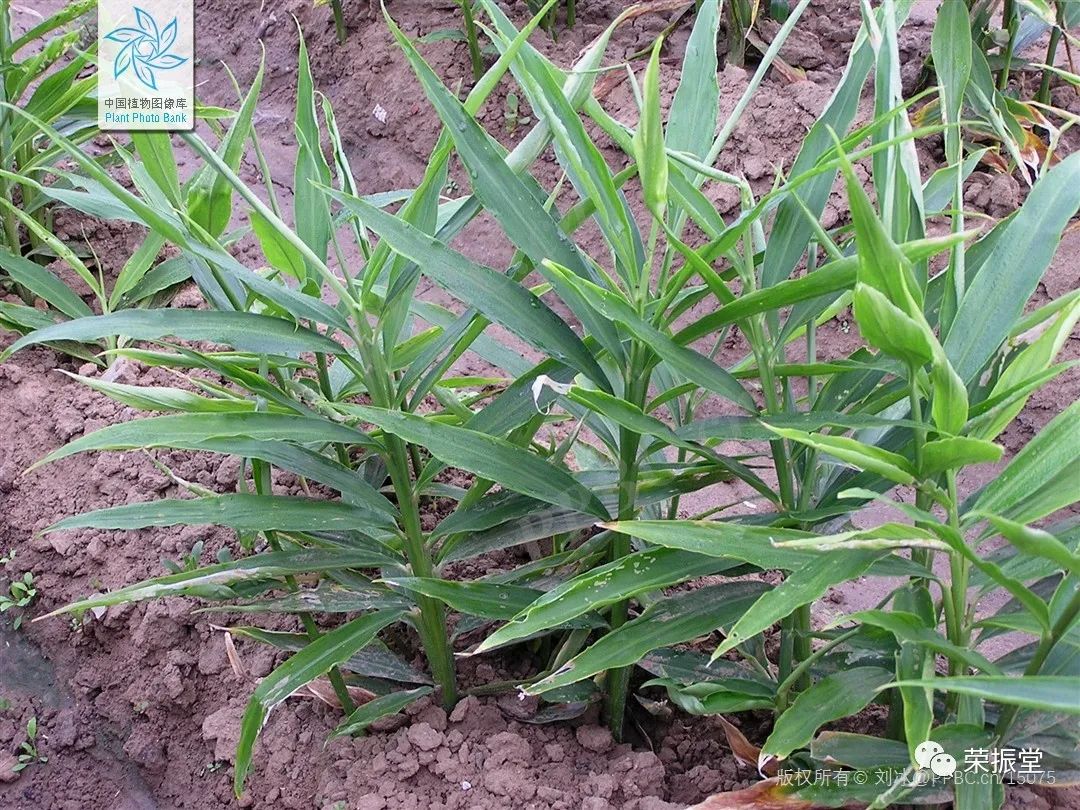
(Image from PPBC, taken by Liu Bing)
Interestingly, the flower clusters of ginger also emerge directly from the rhizome. The structure of the stem, leaves, and flowers is similar to that of cardamom, but the flower stalks of ginger can reach up to 25 cm, with flowers that bloom successively in pale yellow and purple-red colors (cardamom is mainly white, with a small amount of yellow).
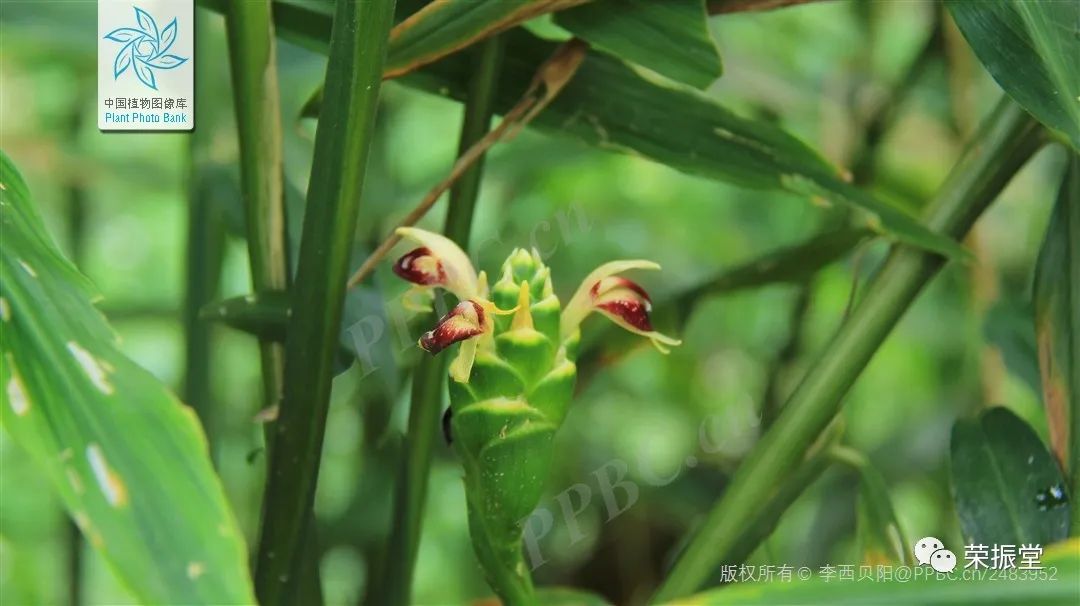
(Image from PPBC, taken by Li Xibei Yang)
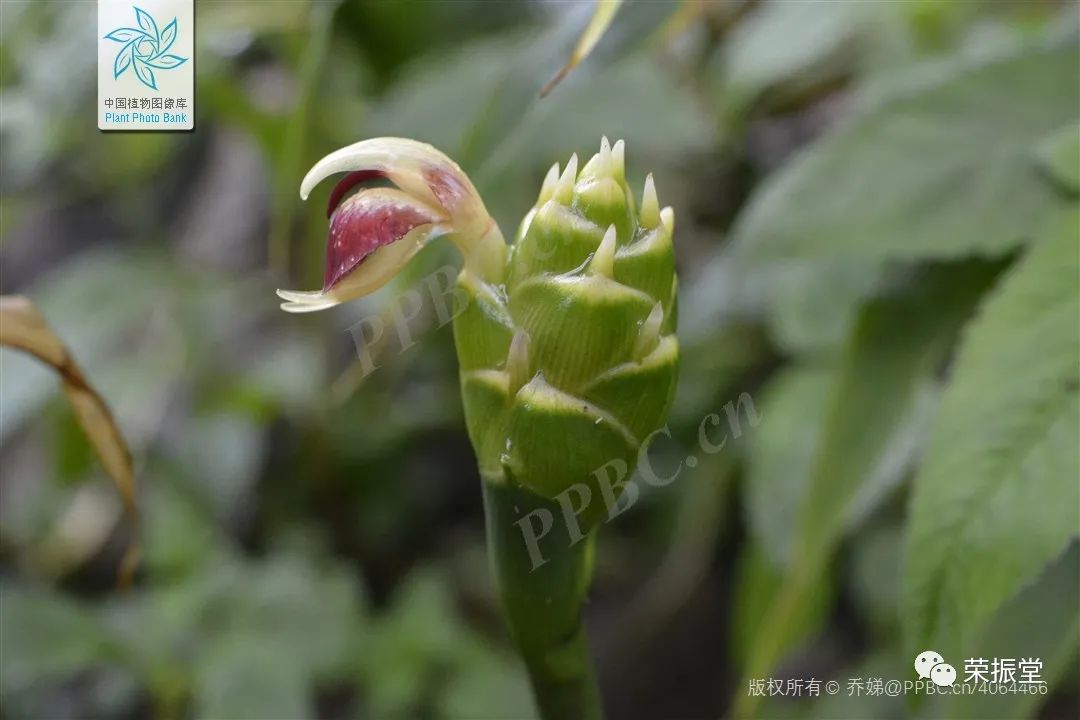
(Image from PPBC, taken by Qiao Di)
More importantly, there is no information about the fruit of ginger; the flowers bloom in autumn, and it is estimated that the fruit will not appear until winter. Therefore, ginger only flowers in tropical regions where the temperature does not drop too low after autumn. Thus, the most common propagation strategy for ginger is the “young ginger division mode” that we see now.
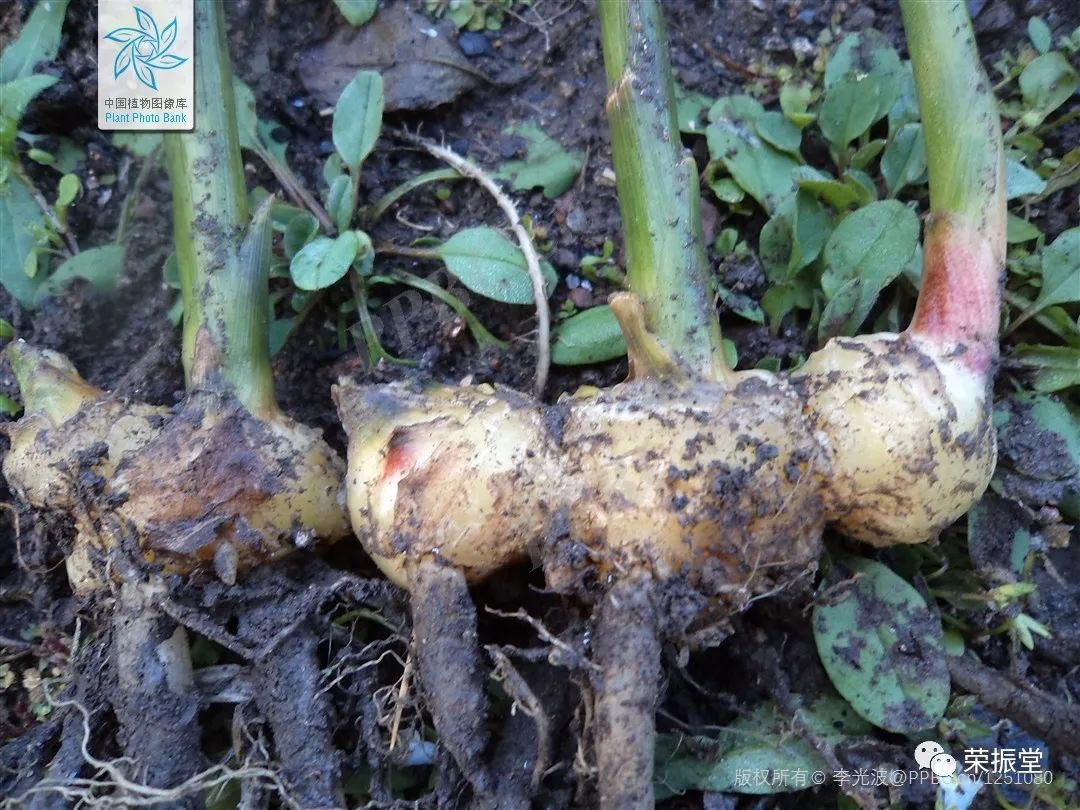
(Image from PPBC, taken by Li Guangbo)
Once the tubers divide and produce young ginger, it can be referred to as mother ginger. Mother ginger will “outwardly” produce its vigorous growth parts, dividing away from the main body. But this is not the end; the lateral buds on the young ginger will continue to sprout, producing new shoots for the second branch, and the base will swell to form a second ginger tuber, called grandson ginger… This process continues to occur for the third, fourth, fifth ginger tubers… Generations seem endless until harvest, forming a complete rhizome composed of mother ginger and multiple generations of young ginger.
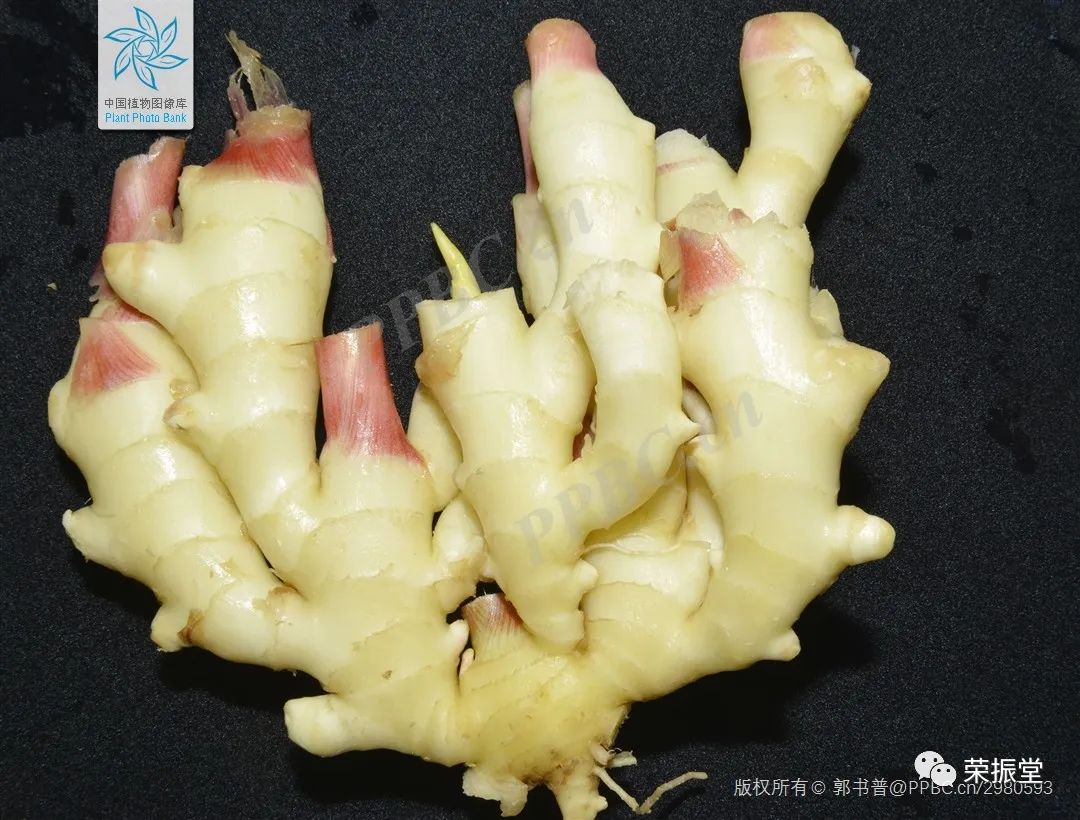
(Image from PPBC, taken by Guo Shupu)
Generally, the more branches ginger has above ground, the more and larger the ginger tubers will be underground, resulting in higher yields. As shown in the image above, “several generations living together”, it is no wonder that there is a name “Ginger Mountain”. See the image below of spring-grown young ginger, marveling at this “crowded” vitality.
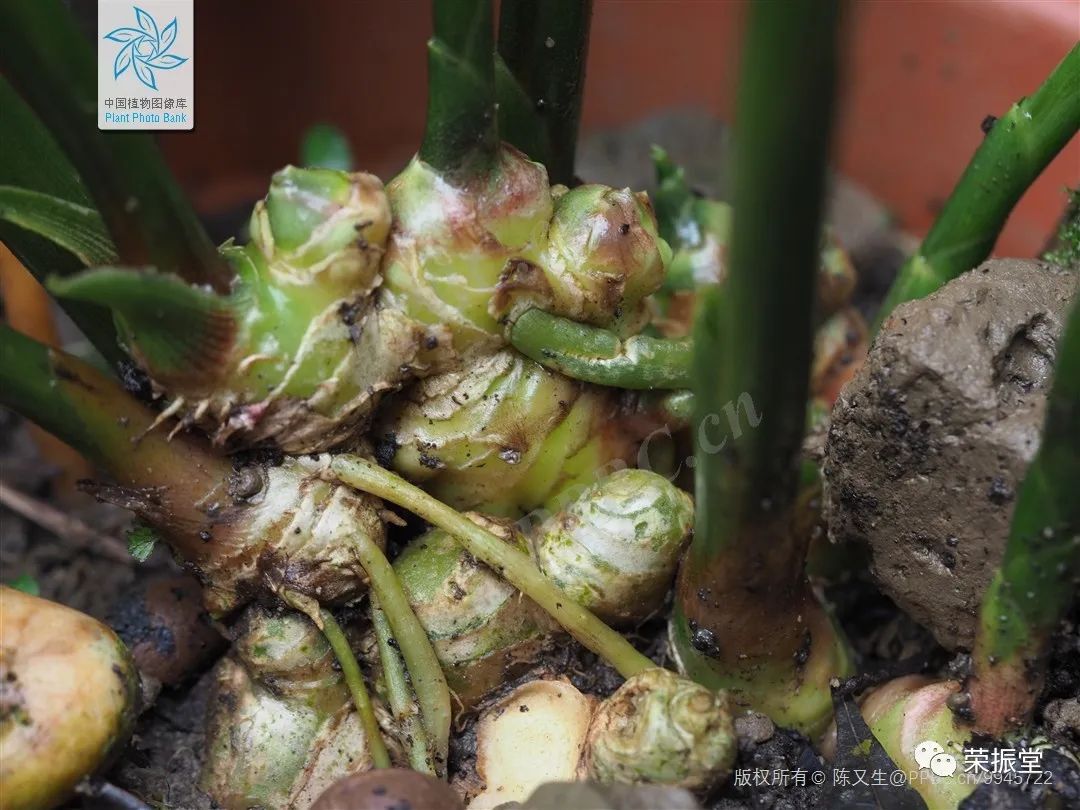
(Image from PPBC, taken by Chen Yousheng)
In cooking and medicinal use, the commonly used part is the offspring, and it is usually harvested at the end of summer when it is tender and has a relatively high water content, full of vitality and effective for the stomach; while dried ginger is commonly used from mother ginger, harvested in winter when its multiple divisions have nearly ceased. (Having transferred its germination and growth power), the reduction in temperature in winter also lowers its division power, leaving behind fibrous interiors (the slices show fibrous structure, which helps to smooth the meridians and collaterals), with a rich aromatic substance (the slices still show scattered yellow oil spots, with a spiciness stronger than that of the offspring).
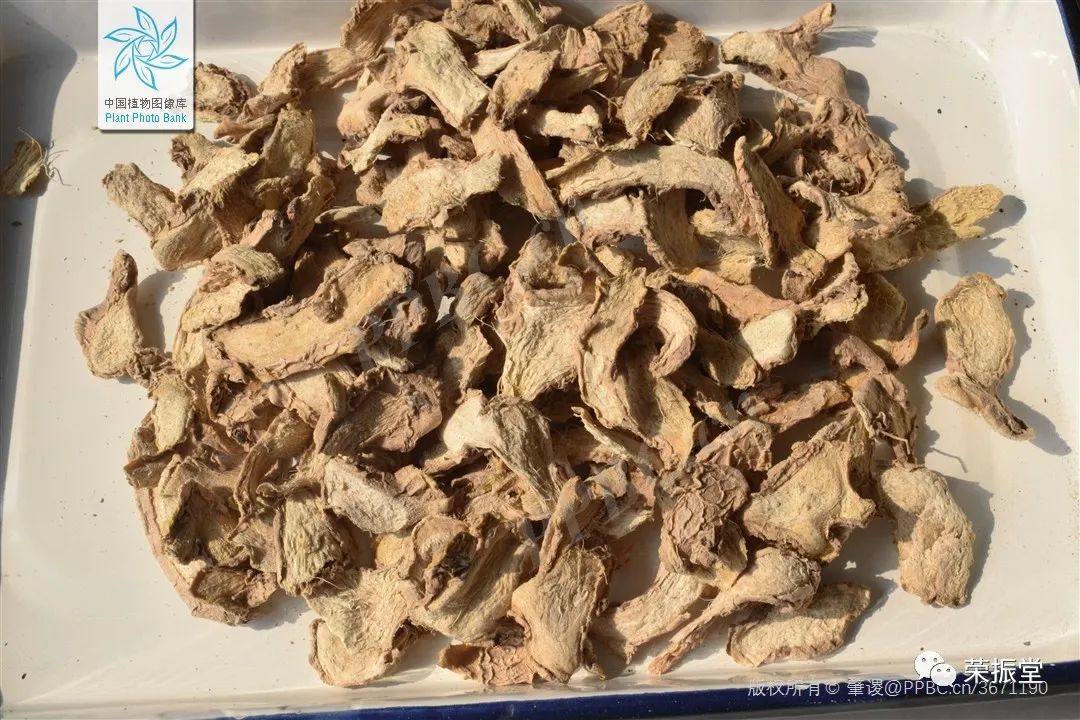
(Image from PPBC, taken by Zhao Su)
Since modern people rarely dig wild, perennial ginger, they do not see what mother ginger looks like after many generations. In a video left by the late Daoist Zhang Zhishun, he mentioned that the real dried ginger he saw was not the sun-dried mother ginger, but the old mother ginger that had exhausted its division power after many generations.
(【Zhang Zhishun Daoist Talks about Dried Ginger】: Bilibili, copy and search this string of letters, BV17G411p7sA)
Nevertheless, to obtain a large amount of dried ginger for medicinal use, it is not possible to wait for many years, so the mother ginger that has undergone several divisions is used for medicine. In the movement of the medicine, the ability to divide is “to move”, while the divided and left behind is “to stay”. Historically, dried ginger has been used—un-dried, un-exhausted mother ginger, thus it can both stay and move. If the mother dried ginger seen by Daoist Zhang is used for medicine, its staying power is commendable, but its moving power is exhausted; if fresh ginger is dried for medicinal use, the efficacy is present but weak, which somewhat misleads the world.
Combining its spicy and hot properties, it is also known to represent the earth element (multiple factors overlap, including shallow soil growth, round and harmonious division, and being both mother and earth), thus warming the middle palace; and its staying and moving dynamics, “staying” can warm and supplement the earth, while “moving” symbolizes the fascia to unblock, primarily dispersing wind and cold.
Fresh ginger enters the stomach, assists in promoting yang, and helps to unblock the kidneys; it can regulate the mechanism of kidney and stomach cells to process hydrogen ions, adjusting the body’s acid-base balance; mobilizing stomach qi to push towards the muscle surface, dispersing wind and cold with its spicy heat (this serves as a supplement to the 2016 article on fresh ginger).
References
OLD SAYING
“Shennong Bencao Jing”:It is used for chest fullness, cough, reverse qi, warming the middle, stopping bleeding, inducing sweating, expelling wind, dampness, diarrhea, and dysentery. Fresh ginger is especially good; long-term use eliminates foul odors and opens the mind.“Leigong’s Explanation of Medicinal Properties”:Fresh ginger is spicy, can move blood, expel cold pathogens, and release the exterior. Cooked ginger is bitter, can stop bleeding, eliminate cold from the stomach, and protect the middle, sinking cold and stubborn cold. If there is no yang in the kidney, and the pulse qi is about to collapse, use black Aconite as a guide.“Qianjin Yifang”:Wind pathogens and various toxins, causing qi stagnation in the skin.“Shennong Bencao Jing Baizhong Lu”:Warming the middle and stopping bleeding, blood returns to the meridians… expelling wind and dampness, treating cold pathogens in the muscles and bones… Spicy and strong qi canexpel filth and open yang. All strong-tasting medicines are for staying, while those with strong qi are for dispersing. Dried ginger has both strong taste and qi, thus it can disperse and also stay. If it does not fully disperse, it does not fully stay, then it rotates between the meridians and organs, expelling cold and dampness, harmonizing blood and moving qi, which is inevitable.“Tangye Bencao”:“Zhen” states:… After processing, the taste is bitter.“Gu Songyuan’s Medical Mirror”:Can guide blood medicines into the blood aspect, guide qi medicines into the qi aspect, and can also expel evil and nourish the new, thus it is used in postpartum formulas.“Depei Bencao”:Opens the organs, unblocks the joints, expels deep cold, and disperses qi stagnation.“Bencao Sibian Lu”:Dried ginger is made from mother ginger after peeling, yellow-white in color and spicy and warm in taste, with a solid texture, being aspecial medicine for warming the middle earth.Note: Ancient texts on the harvesting of dried ginger are also divided; some mention mother ginger, while others do not; its effects are summarized succinctly in “Depei”: “Opens the organs, unblocks the joints, expels deep cold, disperses qi stagnation”; whether to peel mother ginger or not also has slight differences; “Sibian Lu” states that dried ginger is a “special medicine for warming the middle earth”.“Baizhong Lu” mentions “Warming the middle and stopping bleeding, blood returns to the meridians”, “Expelling filth and opening yang”, and also has clear understanding of the trends and methods of action of dried ginger. “Gu Songyuan’s Medical Mirror” states “Expelling evil and nourishing the new, with the meaning of yang generating yin, thus it is used in postpartum formulas”, referring to Shenghua Decoction.There are also many ancient texts not fully recorded here, but the general content is similar. For reference.
“Bencao Gangmu”:For spleen and stomach deficiency and cold, if unable to eat, cook white dried ginger in water until soft, take out and dry, crush into powder, and make into pills the size of a wutou, taking thirty to fifty pills with boiled water, the effect is extremely effective… For diarrhea, use dried ginger (processed) ground into powder, take with thin rice porridge, two qian will cure… For red eyes and pain, use white ginger powder, mix with water and apply to the soles of the feet… For initial onset of carbuncles, use one liang of dried ginger, stir-fried purple, ground into powder, mix with vinegar and apply around the carbuncle, leaving the head.
“Leigong’s Explanation of Medicinal Properties”:Danxi said: Dried ginger disperses lung qi, combined with five flavors can stop cough, treat blood deficiency and fever.
Note: For medicinal combinations, refer to “Gangmu” for the best. The above excerpts are parts of the flexible use of dried ginger alone, both internal and external, for reference; in “Medicinal Properties Explanation”, dried ginger disperses lung qi, while Schisandra astringes the back, the two can be referenced for treating lung issues of deficiency cold and blood deficiency heat.
“Tangye Bencao”:“Heart” states: Dispersing cold pathogens, if used excessively, will deplete original qi; spicy disperses, thus it strengthens fire and consumes qi, so it must be moderated with fresh licorice.
“Gu Songyuan’s Medical Mirror”:Spicy can disperse qi and move blood, long-term use damages yin and harms the eyes; if the disease is not cold, be careful not to use it. Pregnant women taking it will cause internal consumption of the fetus.
“Bencao Fengyuan”:Do not use for yin deficiency with heat or blood heat causing reckless movement, as it disperses qi and moves blood.
“Bencao Harm and Benefit”:It is very spicy, and spiciness can be excessive, also dispersing qi and moving blood, harming yin and damaging the eyes. (Many ancient texts describe it as “long-term use causes dimness of vision”)
Note: The first concern with spicy and hot medicines is improper use. As the saying goes, there are great useful products, but if the timing and position are not grasped well, for example, using it for “non-cold diseases” can also cause great harm.
The second concern is excessive use depleting original qi, and fresh licorice must be used to moderate it; dispersing qi and moving blood can damage yin and harm the eyes, with multiple ancient texts mentioning “long-term use causes dimness of vision” (although they also say “long-term use eliminates foul odors and opens the mind”).Moreover, for those with yin deficiency and heat, or blood heat causing reckless movement, it should not be used.
In “Gu Songyuan’s Medical Mirror”, it is mentioned that “Pregnant women taking it will cause internal consumption of the fetus”, although no other ancient texts mention this, it is worth noting and requires deeper understanding to determine its correctness. Clinical reference is needed.
For previous summaries, please click the links below:A Detailed Discussion on Chinese Medicine | Summary of Heat-Clearing and Detoxifying Herbs (Hexagram Position)A Detailed Discussion on Chinese Medicine | Summary of Heat-Clearing and Damp-Drying HerbsA Detailed Discussion on Chinese Medicine | Summary of Heat-Clearing and Fire-Clearing Herbs (Hexagram Position)A Detailed Discussion on Chinese Medicine | Summary of Exterior-Releasing and Cold-Dispersing HerbsA Detailed Discussion on Chinese Medicine | Summary of Wind-Dispersing and Heat-Clearing Herbs (Bagua)A Detailed Discussion on Chinese Medicine | Summary of Heat-Clearing and Blood-Cooling Herbs (Bagua)A Detailed Discussion on Chinese Medicine | Summary of Heat-Clearing and Deficiency-Heat Herbs (Bagua)A Detailed Discussion on Chinese Medicine | Summary of Laxative Herbs (Bagua)A Detailed Discussion on Chinese Medicine | Summary of Wind-Dispersing and Damp-Removing Herbs (Position)A Detailed Discussion on Chinese Medicine | Summary of Wind-Damp-Heat-Removing Herbs (Position)A Detailed Discussion on Chinese Medicine | Summary of Wind-Damp-Strengthening and Bone-Strengthening Herbs (Position)A Detailed Discussion on Chinese Medicine | Summary of Damp-Resolving Herbs (Position + Hexagram Symbol)A Detailed Discussion on Chinese Medicine | Summary of Water-Draining and Swelling-Reducing Herbs (Position)A Detailed Discussion on Chinese Medicine | Summary of Water-Draining and Urination-Promoting Herbs (Position)A Detailed Discussion on Chinese Medicine | Summary of Damp-Removing and Yellow-Reducing Herbs (Position)Scattered Discussions:
- A Detailed Discussion on Chinese Medicine | Mulberry Fruit—Sweet and Sour, Nourishing the Five Organs, Generating Fluids, Thickening the Intestines, Reducing Spleen Heat
- A Detailed Discussion on Chinese Medicine | Cat’s Claw—Sweet and Spicy, Gathering Yang, Breaking Stagnation, Standing Firm in the Perineum, Collecting Lymph
- A Detailed Discussion on Chinese Medicine | Bai Zhu (White Atractylodes)—Earth Virtue, Harmonizing Qi and Blood, Generating Fluids, Calming the Middle, Building Muscle

